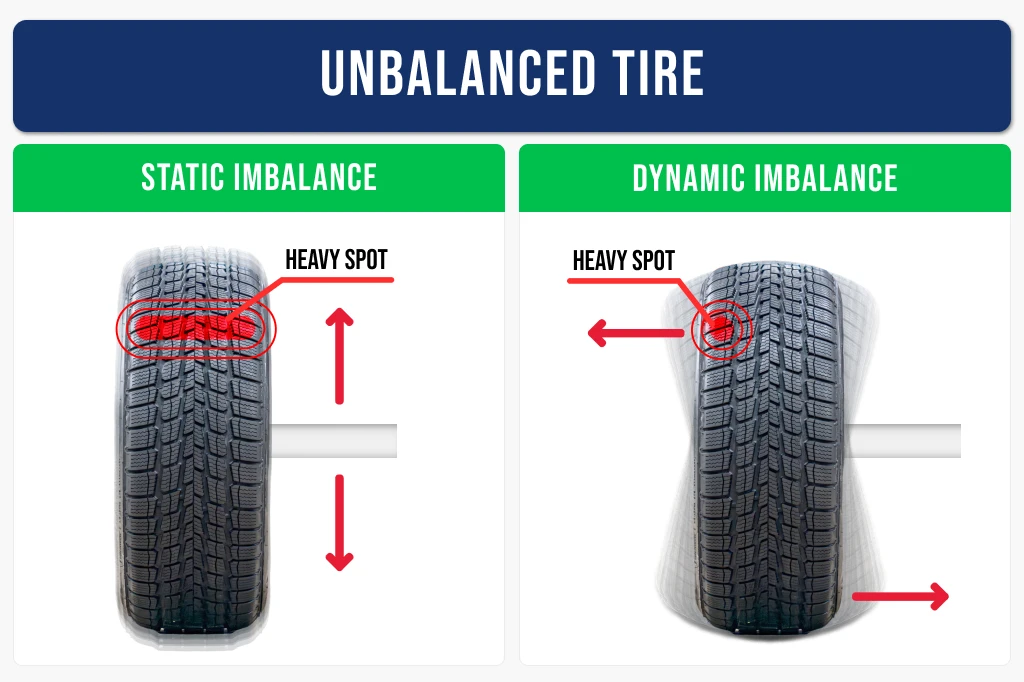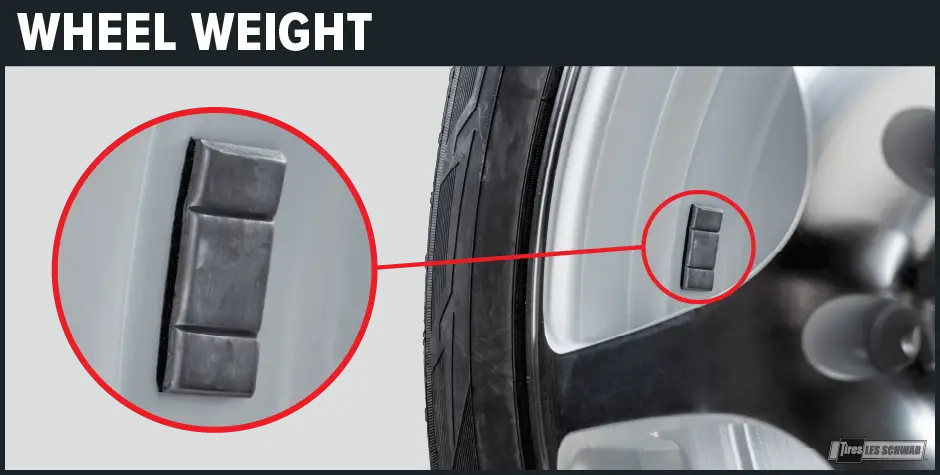Have you ever noticed your steering wheel vibrating while driving? Or maybe your car feels a bit off even on smooth roads?
If so, it might be time to think about tire balancing. But what exactly is tire balancing, and why should you care? Understanding this simple yet crucial process can significantly enhance your driving experience and extend the life of your tires.
By the end of this article, you’ll learn how tire balancing can save you money and keep you safe on the road. Ready to discover the secret to a smoother ride? Let’s dive in.
Tire Balancing Basics
Tire balancing is crucial for a smooth ride. It ensures even weight distribution across your tires. Proper tire balance prevents vibrations and uneven wear. Regular balancing improves vehicle performance and extends tire life. Let’s explore the basics of tire balancing.
What Is Tire Balancing?
Tire balancing involves adjusting the weight distribution. Technicians use specialized equipment for this process. They place small weights on the rim to achieve balance. This reduces vibration and enhances driving comfort.
Why Is Tire Balancing Important?
Proper tire balance prevents uneven tire wear. It enhances fuel efficiency and ensures a smoother ride. Balanced tires reduce stress on the suspension system. This leads to fewer maintenance issues over time.
How Often Should Tires Be Balanced?
Tires should be balanced every 5,000 to 6,000 miles. Balance them whenever you notice vibrations or uneven wear. Regular balancing keeps your vehicle running smoothly. It contributes to safe driving conditions.
Vibrations in the steering wheel signal imbalance. Uneven tire wear indicates a need for balancing. If your vehicle pulls to one side, check tire balance. These signs can affect driving comfort and safety.

Credit: gotire.com
Importance Of Tire Balancing
Tire balancing ensures smooth driving and extends tire life. It involves adjusting the weight distribution around the tire and wheel. Proper balance prevents vibrations, improves fuel efficiency, and enhances safety. Regular checks keep your ride comfortable and your vehicle in top condition.
Understanding the importance of tire balancing could be the key to a smoother, safer, and more comfortable ride. Tire balancing ensures that the weight of your vehicle is evenly distributed across all tires. This might sound technical, but it plays a crucial role in your driving experience and vehicle maintenance. If you’ve ever felt your steering wheel vibrating at high speeds, it might be time to check your tire balance. Regularly balancing your tires can prevent uneven tire wear, extend the life of your tires, and even improve fuel efficiency. You might be wondering, is tire balancing really that important? Let’s delve into why it should be a priority in your vehicle maintenance routine.Ensures A Smooth Ride
Tire balancing helps your car run smoothly. Without it, you might feel vibrations and bumps even on flat roads. These vibrations often come from the tires being unbalanced, causing parts of your car to shake. A smooth ride is not just about comfort. It affects how safely you can control your car. A car with balanced tires will steer more accurately and respond better to your inputs.Extends Tire Lifespan
Balancing your tires regularly can significantly extend their lifespan. Tires that are not balanced wear out unevenly. This uneven wear means you might have to replace your tires much sooner than expected. Imagine buying a pair of shoes and only wearing out the left one. You wouldn’t want to replace both shoes just because one is worn out, would you? Balancing tires helps ensure that all tires wear evenly.Improves Fuel Efficiency
Many drivers are unaware that tire balancing can improve fuel efficiency. When tires are not balanced, your engine has to work harder to move the car. This extra work requires more fuel. By balancing your tires, your car uses fuel more efficiently. This not only saves money but also benefits the environment by reducing emissions. You might notice fewer trips to the gas station, which is a win-win situation.Prevents Wear And Tear On Vehicle Components
Unbalanced tires can lead to more than just uneven tire wear. They can cause additional stress on your car’s suspension and steering systems. This stress may result in costly repairs if left unchecked. By maintaining balanced tires, you protect these critical components from unnecessary wear and tear. This preventive measure can save you from unexpected breakdowns and repair bills.Enhances Safety
Safety should always be a top priority when driving. Unbalanced tires can compromise your vehicle’s handling and stability. This might not seem like a big deal on a sunny day but imagine trying to make a quick maneuver in an emergency. Balanced tires ensure that your vehicle responds predictably and reliably. It’s a simple step that enhances your safety and peace of mind on the road. Isn’t it worth considering for such a crucial aspect of driving?How Tire Balancing Works
Tire balancing ensures even weight distribution across a tire and wheel assembly. This process prevents vibrations and uneven tread wear. Technicians use specialized machines to measure imbalance and attach weights to correct it.
Understanding how tire balancing works can save you from a bumpy ride and unnecessary wear on your tires. Have you ever noticed your steering wheel vibrating at certain speeds? That’s often a sign that your tires are out of balance. Tire balancing isn’t just for smooth driving; it plays a crucial role in maintaining your vehicle’s performance and extending the life of your tires. Let’s dive into how this process works.Static Vs Dynamic Balancing
Static balancing focuses on the weight distribution along the wheel’s vertical axis. Imagine placing your tire on a spindle and it naturally rotates to the heaviest point. Mechanics add small weights opposite this point to achieve balance. It’s simple but only effective when the imbalance is uniform. Dynamic balancing, however, considers both the vertical and horizontal imbalances. This method addresses side-to-side wobbling and involves rotating the tire at high speeds. Mechanics use machines to detect imbalances and apply weights where needed. Ever wonder why your car feels smoother after a tire shop visit? Dynamic balancing is often the reason.Balancing Equipment And Tools
To balance tires accurately, professionals use specialized equipment like the balancing machine. This machine spins your tire at high speeds to detect imbalances. Once the machine pinpoints the issues, technicians use small metal weights to correct them. You might have noticed those little weights clipped to the edge of your wheel rim. These weights are crucial for balancing. There are also stick-on weights for rims that can’t handle clips. Balancing is both an art and a science, requiring precision and the right tools. Have you ever tried balancing your tires at home? It’s challenging without the right equipment. While DIY might save money, it’s often worth getting a professional to ensure a job well done. Wouldn’t you prefer a smooth ride over a shaky one? Remember, balanced tires mean safer driving and longer-lasting tires. Next time you get your tires balanced, you’ll know the science behind that smooth journey.Signs Your Tires Need Balancing
Tire balancing is crucial for a smooth and safe drive. It involves adjusting the weight around the tire and wheel assembly. Unbalanced tires lead to several issues. Recognizing these signs early can save you time and money.
Uneven Tire Wear
Uneven tire wear is a common sign of imbalance. Check your tires for irregular tread patterns. The wear may appear more on one side or in patches. This uneven wear reduces tire lifespan. It also affects vehicle handling.
Vibrations And Noise
Do you feel vibrations in the steering wheel? This often indicates unbalanced tires. These vibrations increase with speed. You might also hear unusual noises. This noise usually comes from the tire area. Both these signs mean your tires need balancing.
Tire Balancing Process
Tire balancing is a crucial aspect of vehicle maintenance that ensures your ride is smooth and safe. Without proper balancing, your tires might cause vibrations, uneven wear, and even damage to your vehicle’s suspension system. Understanding the tire balancing process can help you appreciate why it’s essential for both performance and longevity. Let’s dive into the details of how this process works.
Preparation Steps
Before balancing your tires, there are a few steps you need to follow. First, ensure your vehicle is on a flat surface. This provides stability during the process. Next, clean your tires thoroughly. Dirt and debris can affect the accuracy of the balancing. Finally, inspect your tires for any visible damage or wear. If something seems off, it might require more than just balancing.
Balancing Procedure
Once the tires are prepared, the balancing process begins. Each tire is removed and placed on a balancing machine. This machine spins the tire to identify any imbalance. Weights are then added to the rim to counteract any unevenness. The goal is to distribute the weight equally across the tire. This ensures a smooth rotation when you’re driving.
Have you ever noticed a vibration at certain speeds? This might be due to unbalanced tires. Balancing them can often resolve these annoying issues. It’s surprising how such a small adjustment can make a huge difference in your driving experience. Tire balancing is not just about comfort; it’s about maintaining your vehicle’s integrity and safety.
Next time you feel that familiar wobble, consider checking your tire balance. It might be the simple fix your car needs. Regularly balancing your tires can extend their lifespan and enhance your driving experience. Why compromise on comfort when a quick visit to your local mechanic can ensure your ride is smooth and secure?
Benefits Of Regular Tire Balancing
Tire balancing is crucial for a smooth and safe driving experience. Regular balancing offers numerous benefits. These advantages enhance both comfort and vehicle performance. Let’s explore some key benefits of regular tire balancing.
Improved Ride Comfort
Balanced tires ensure a smoother ride. They reduce vibrations felt in the car. This leads to a more pleasant driving experience. Passengers enjoy a quieter journey. Drivers experience less fatigue on long trips.
Extended Tire Lifespan
Regular tire balancing helps tires wear evenly. Uneven wear reduces tire lifespan. Balanced tires distribute weight evenly. This prevents premature tire wear. Proper balance means fewer replacements over time. Save money by extending tire life.
Diy Vs Professional Balancing
Tire balancing ensures smooth driving and safety by evenly distributing weight around the wheel. DIY balancing might save money but requires tools and expertise for accuracy. Professional balancing offers precision and peace of mind, using specialized equipment to achieve optimal performance.
Choose wisely based on your needs and skills.
Tire balancing is a crucial aspect of vehicle maintenance that ensures a smooth ride and extends the life of your tires. When faced with the choice of DIY vs professional tire balancing, many car owners are torn between saving money and ensuring precision. Whether you’re a hands-on enthusiast or prefer leaving it to the experts, each option comes with its own set of advantages and challenges.Pros And Cons
Taking the DIY route can be quite rewarding if you enjoy working on your car. You might save some money and gain a sense of accomplishment. However, without the right equipment, achieving the perfect balance can be tricky. On the flip side, professional balancing offers precision with the help of advanced tools. The downside? It often comes with a higher price tag. Additionally, you might need to schedule an appointment and wait, which can be inconvenient.When To Seek Professional Help
Ask yourself: Is your car vibrating at high speeds? This could be a sign that your DIY efforts didn’t quite hit the mark. If you notice uneven tire wear or if your vehicle pulls to one side, it might be time to consult a professional. Consider your experience level. If you’re new to car maintenance, professional help ensures peace of mind and safety. Remember, an unbalanced tire can affect not only your car’s performance but also your safety on the road. Ultimately, your choice depends on your comfort level and the tools you have. Have you ever tried balancing your tires at home? What was your experience like? Balancing the cost, time, and precision can guide you to the best decision for your situation.
Credit: www.lesschwab.com
Common Misconceptions
Tire balancing is crucial for a smooth ride, but there are many misconceptions surrounding it. You might have heard conflicting advice about how often it should be done or its impact on vehicle performance. These misconceptions can lead to neglecting this vital maintenance task, resulting in uneven tire wear and uncomfortable driving experiences. Let’s clear up some of the most common misunderstandings.
Misconception 1: Tire Balancing Is The Same As Wheel Alignment
Many believe tire balancing and wheel alignment are interchangeable terms. They are not. Tire balancing involves equalizing the weight distribution around the tire and wheel assembly. Wheel alignment, however, adjusts the angles of the wheels to ensure they meet the road properly. Confusing these can lead to improper maintenance choices.
Misconception 2: You Only Need To Balance Tires When You Notice A Problem
Relying on noticeable issues like vibrations to indicate the need for tire balancing can be misleading. Often, minor imbalances don’t create obvious symptoms but can still cause long-term damage. Regular checks are essential to maintain tire health and prevent uneven wear.
Misconception 3: New Tires Don’t Require Balancing
It’s a common belief that new tires are perfectly balanced. In reality, even new tires can have slight imbalances due to manufacturing inconsistencies. Balancing them ensures they perform optimally from the start, improving your driving experience and tire longevity.
Misconception 4: Tire Balancing Is A One-time Fix
Some assume once tires are balanced, they stay balanced forever. Road conditions, wear, and other factors can alter balance over time. Regular maintenance is necessary to keep your vehicle running smoothly. How often do you balance your tires?
Addressing these misconceptions helps ensure your tires are properly balanced, contributing to a safer and smoother ride. Have you encountered any of these misunderstandings? Share your experience and learn why regular tire balancing is crucial for your vehicle’s performance.

Credit: www.utires.com
Frequently Asked Questions
What Is Tire Balancing?
Tire balancing ensures even weight distribution around the tire. This process minimizes vibrations, providing a smoother ride. It helps extend tire life and enhances vehicle performance. Properly balanced tires improve fuel efficiency and driving comfort. Regular balancing is crucial after mounting new tires or experiencing vibration issues.
Why Is Tire Balancing Important?
Tire balancing prevents uneven tire wear and vibrations. It ensures a smoother driving experience and prolongs tire life. Proper balancing improves fuel efficiency and vehicle handling. Neglecting tire balancing can lead to increased wear and potential vehicle damage. Regular checks are essential for optimal performance.
How Often Should Tires Be Balanced?
Tires should be balanced every 5,000 to 6,000 miles. Regular balancing is recommended when installing new tires. If you notice vibrations or uneven wear, consider immediate balancing. Consistent maintenance ensures a smooth ride and extends tire life. Consult your vehicle’s manual for specific guidance.
What Are Signs Of Unbalanced Tires?
Unbalanced tires often cause vibrations in the steering wheel. You might notice uneven tire wear or reduced fuel efficiency. The vehicle may handle poorly or make unusual noises. If you experience these issues, tire balancing might be necessary. Regular checks help maintain optimal performance.
Conclusion
Tire balancing keeps your ride smooth and safe. It prevents uneven wear. This means tires last longer. Balanced tires also save fuel. They reduce vibrations, making drives more comfortable. Regular tire checks are important. They help spot issues early. Always consult a professional for balancing.
This ensures accuracy. Regular maintenance benefits your car and wallet. So, keep tire balancing in mind. It truly makes a difference. A balanced car is a happy car. Enjoy safer, smoother journeys.
Recent Posts
Facing intermittent power steering noise in Chevy Tahoe? We offer expert insights into the causes and effective DIY fixes to get you back on the road.
Is your car suffering from a squealing belt during morning startup? We offer practical solutions to fix it.

